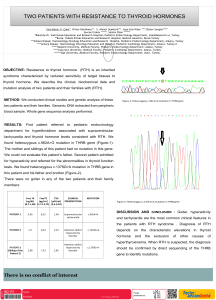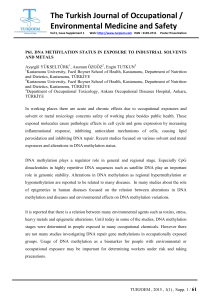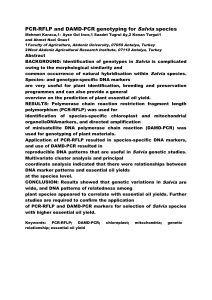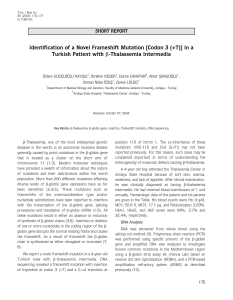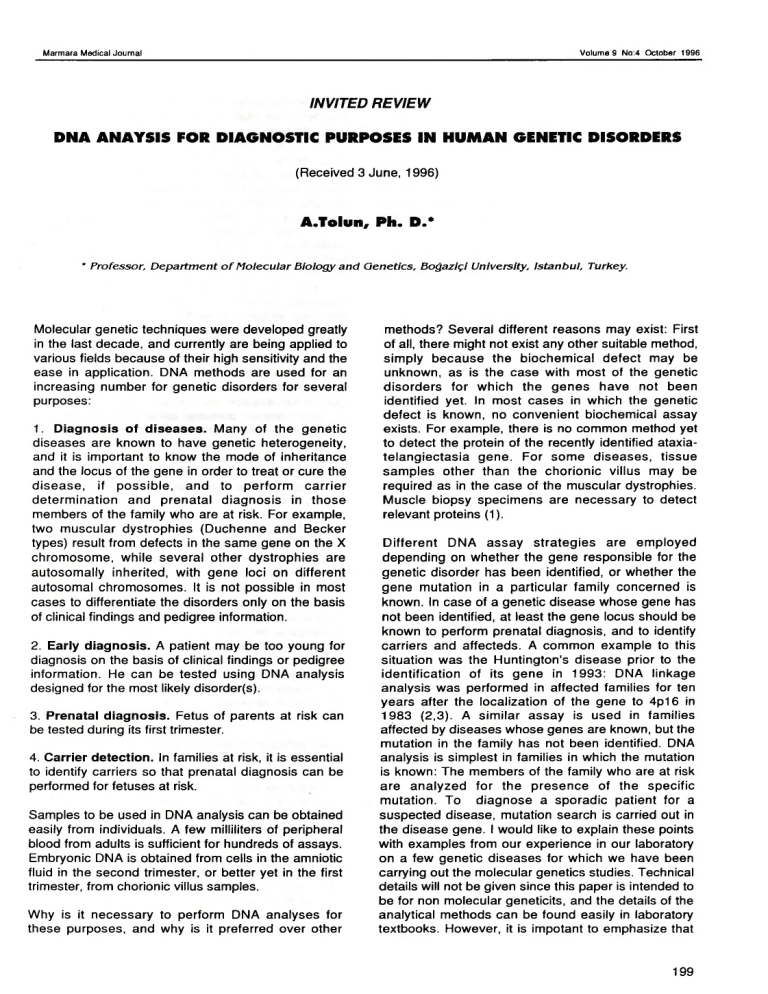
Volume 9 No:4 October 1996
Marmara Medical Journal
INVITED REVIEW
D N A AN AYSIS FOR DIAGNOSTIC PURPOSES IN H U M AN GENETIC DISORDERS
(Received 3 June, 1996)
A .To lu n , Ph. D.*
* P ro fe s s o r, D e p a rtm e n t o f M o le c u la r B io lo g y a n d G e n e tic s , B o ğ a z iç i U n iv e rs ity , Is ta n b u l, T urkey.
Molecular genetic techniques were developed greatly
in the last decade, and currently are being applied to
various fields because of their high sensitivity and the
ease in application. DNA methods are used for an
increasing number for genetic disorders for several
purposes:
1. Diagnosis of diseases. Many of the genetic
diseases are known to have genetic heterogeneity,
and it is important to know the mode of inheritance
and the locus of the gene in order to treat or cure the
disease, if possible, and to perform carrier
determination and prenatal diagnosis in those
members of the family who are at risk. For example,
two muscular dystrophies (Duchenne and Becker
types) result from defects in the same gene on the X
chromosome, while several other dystrophies are
autosomally inherited, with gene loci on different
autosomal chromosomes. It is not possible in most
cases to differentiate the disorders only on the basis
of clinical findings and pedigree information.
2. Early diagnosis. A patient may be too young for
diagnosis on the basis of clinical findings or pedigree
information. He can be tested using DNA analysis
designed for the most likely disorder(s).
3. Prenatal diagnosis. Fetus of parents at risk can
be tested during its first trimester.
4. Carrier detection. In families at risk, it is essential
to identify carriers so that prenatal diagnosis can be
performed for fetuses at risk.
Samples to be used in DNA analysis can be obtained
easily from individuals. A few milliliters of peripheral
blood from adults is sufficient for hundreds of assays.
Embryonic DNA is obtained from cells in the amniotic
fluid in the second trimester, or better yet in the first
trimester, from chorionic villus samples.
Why is it necessary to perform DNA analyses for
these purposes, and why is it preferred over other
methods? Several different reasons may exist: First
of all, there might not exist any other suitable method,
simply because the biochemical defect may be
unknown, as is the case with most of the genetic
disorders for which the genes have not been
identified yet. In most cases in which the genetic
defect is known, no convenient biochemical assay
exists. For example, there is no common method yet
to detect the protein of the recently identified ataxiatelangiectasia gene. For some diseases, tissue
samples other than the chorionic villus may be
required as in the case of the muscular dystrophies.
Muscle biopsy specimens are necessary to detect
relevant proteins (1).
Different DNA assay strategies are employed
depending on whether the gene responsible for the
genetic disorder has been identified, or whether the
gene mutation in a particular family concerned is
known. In case of a genetic disease whose gene has
not been identified, at least the gene locus should be
known to perform prenatal diagnosis, and to identify
carriers and affecteds. A common example to this
situation was the Huntington's disease prior to the
identification of its gene in 1993: DNA linkage
analysis was performed in affected families for ten
years after the localization of the gene to 4p16 in
1983 (2,3). A similar assay is used in families
affected by diseases whose genes are known, but the
mutation in the family has not been identified. DNA
analysis is simplest in families in which the mutation
is known: The members of the family who are at risk
are analyzed for the presence of the specific
mutation. To diagnose a sporadic patient for a
suspected disease, mutation search is carried out in
the disease gene. I would like to explain these points
with examples from our experience in our laboratory
on a few genetic diseases for which we have been
carrying out the molecular genetics studies. Technical
details will not be given since this paper is intended to
be for non molecular geneticits, and the details of the
analytical methods can be found easily in laboratory
textbooks. However, it is impotant to emphasize that
199
Marmara Medical Journal
the techniques employ mostly DNA fragments
amplified by the polymerase chain reaction (PCR)(4).
Hundreds of thousands of copies of specific gene
regions can be obtained this way, rendering DNA
assays much simpler than if the whole genomic DNA
were to be used. There is intensive effort to improve
the general methods constantly since the commercial
benefit is formidable. Several private laboratories are
offering DNA analysis services, along with
laboratories in hospitals which can offer the service
for a legal fee.
The various approaches for DNA analysis suitable for
different situations are described below:
A. A familial case with a disorder for which either
the gene has been localized but not identified, or
the gene is known but the mutation in the family
has not been identified. The only strategy is to use
DNA linkage analysis, which requires a study of all
family members to determine the inheritance of the
disease allele by the individuals. Thus it is possible to
identify the members who carry one or both parental
disease alleles, and also those who are completely
normal genotypically with regard to the disease.
Linkage analysis employs DNA polymorphisms. A
DNA polymorphism is found most commonly in the
parts of our genome that do not code for proteins.
Thus a DNA polymorphism does not affect a protein's
structure. These polymorphisms are DNA variations
that are thought to have arisen several thousands of
years ago. It is estimated that one in every two
hundred nucleotides (building blocks of the DNA) are
different in any two unrelated individuals.
Let us assume that there is a DNA polymorphism that
is very close to a disease gene locus. In a family
affected with the genetic disorder, it is possible to
determine which of the alleles is inherited together
with the disease allele, i.e. linked to it: thus the
polymorphism is considered a marker. A specific
allele of the marker has no general association with
the disease allele: different alleles might be linked
with the disease gene in different families. Suppose
in a family affected by Duchenne muscular dystrophy
(DMD), a fatal X-linked neuromuscular disorder, a
patient carries allele 1 at the gene locus, and the
mother carries allele 1, as expected, and also a
different allele, say allele 2. In the mother's next
pregnancy for a male fetus, the fetus will either carry
allele 1, in which case he will be considered to be
affected, or allele 2, indicating that he is normal.
Similarly, her daughter who has inherited a maternal
allele 1 is a carrier. However, to determine the
maternal allele, the paternal allele needs to be
known. If the father's DNA sample is not available, his
allele may be deduced from those of several
daughters'. The daughters' common allele represents
200
Volume 9 No:4 October 1996
the paternal allele. Let us assume that one of the
daughters has allele 1 (A1) and allele 2 (A2), and the
other A2 and A2. This wil show that the paternal
allele is A2. The assay is not so simple in
autosomally inherited diseases, since each parent
carries one disease allele. Another example for
linkage analysis we were obliged to perform in the
lack of a key family member's DNA sample was when
the patient was no longer alive. Two sisters applied
during pregnancy, and the only other blood sample
available was that of the mother's. Both the affected
brother and the father had died several years ago.
We found that the mother was homozygous for an
allele at the gene locus (let us say A1), and both
daughters had alleles A1 and A2, thus the paternal
allele was deduced to be A2. Since the son had died
of DMD (X-linked), mother was considered a carrier,
and either of her alleles (both being A1) could have
been linked to the disease. As a result, luckily, both of
the daughters were informative at the locus, and the
paternal allele was known. Since there was no way to
identify the disease-linked allele, even if the mother
were informative, maternal allele exclusion was the
only way to realize prenatal diagnosis. Upon analysis
of fetal DNA samples, it became obvious that the
younger daughter had passed her maternal allele to
her male fetus, thus he was at risk (50%), while the
male fetus of the older daughter was more lucky,
having inherited his mother's paternal allele with no
risk.
An individual is said to be informative if he/she is a
heterozygote at the locus of the polymorphism. This
is essential in determining the inheritance (by the
sibs) of the disease allele which is linked to the
polymorphic marker. In the example above, the
mother was not informative in the A locus. It may be
necessary to test an individual for several
polymorphic markers at or close to the gene locus to
come across a marker for which the individual is
informative. Thus polymorphisms with a wide
distribution in the population are more useful. This
property is observed more commonly at loci with
more than two alleles.
DNA polymorphisms are of two types: restriction
enzyme fragment length polymorphisms (RFLP) and
microsatellites of variable repeat number. Most
RFLP’s have only two alleles, the less frequent being
around 20-45 percent, resulting in a heterozygote
frequency of 32-50 percent. Restriction enzymes are
.used to determine the alleles. Microsatellites, on the
other hand, typically have a very large number of
alleles (3-20 or more), raising the heterozygote
frequency to over 80 percent. The polymorphic region
of an individual, when amplified by PCR, contains
fragments of two different sizes. These fragments can
be resolved on suitable electrophoresis gels.
Marmara Medical Journal
B. A familial case with a known mutation. When
the mutation in a particular family is known, members
can be screened for that specific mutation. With the
available mutation detection methods, this can be
done very efficiently in a short time. This approach
has two advantages over the linkage analysis
described above: A family study is not necessary,
thus non availability of samples from all members
would not hinder the analysis, and there is no risk of
misdiagnosis due to DNA recombination
(chromosomal crossing over) as posed by linkage
analysis when the polymorphic marker is not very
close to the gene locus.
C. A family with a single case. A definite diagnosis
is very important, since this will determine both what
should be done for treatment, as well as the
strategies for carrier detection and prenatal
diagnosis. For example, B-thalassemia in a child can
be diagnosed easily by a protein assay. Although
carrier detection can be performed with the same
method, prenatal diagnosis preferably requires DNA
analysis. Either linkage analysis for the family or
mutation detection in the patient can be done. The
gene is small, and reported sporadic cases are
extremely rare. However, the situation is very
different for most other diseases such as the
muscular dystrophies. Protein assays are expensive,
complicated and are offered in few centers. Diagnosis
is not reliable if based only on clinical findings,
because there are several types of the disease
resulting from different genes. There are X-linked
types, and there are autosomal types. Because the
X-linked type (Duchenne/Becker muscular dystrophy:
DMD/BMD) is the most common of the muscular
dystrophies, mutation analysis designed specifically
for this disorder is performed on all suspected cases.
We find about 30 percent of the suspected cases to
be X-linked. DNA deletions are common in this
disease: About 60 percent of patients have deletions.
Thus 60 percent of clinically uncertain DMD/BMD
cases are diagnosed rapidly by deletion analysis. For
the others, protein assay is necessary and is
performed in the biochemistry laboratory of the
neuromuscular disease clinics in Istanbul Medical
School. A muscle biopsy section is immunostained
for proteins of various genes for final diagnosis.
What can be done if clinical findings do not lead to a
definite diagnosis, and if no chemical method is
available in case of a patient with no family history? A
search for mutation is launched in the most likely
gene. This is the approach we take for cystic fibrosis
patients whose clinical findings are not in total
agreement with classical cystic fibrosis. However, the
Volume 9 No:4 October 1996
analysis takes a very long time, since it involves the
analysis of 27 exons using the method of denaturing
gradient gel electrophoresis for point mutations
(mutations involving only 1-3 nucleotides).
Problems to be considered:
In some genetic disorders sporadic cases are very
frequent. In DMD one third of all cases are estimated
to be sporadic, corresponding to one in ten thousand
boys. Thus in a family with a single affected boy, the
sisters carrying the allele with the same marker may
or may not be carriers, depending on when the
mutation (the disease allele) arose. The mutation
might have arisen in a germ cell of the mother or of
any of her ancestors. In the former case only the
affected has the mutation, while in the latter, a parent
is a carrier. Also, the mutation might have arisen in a
progenitor of a germ cell, thus there would be a large
number of germ cells that harbor the mutation, a
phenomenon known as germinal mosaicism. A
germinally mosaic person possibly may have several
progeny with identical mutations, even though she/he
does not carry the mutation in the blood cells, which
is the tissue commonly used for DNA analysis. In
DMD, germinal mosaicism is estimated to be 10-15%
in mothers of affected boys, and much less in the
fathers. In these cases, a linkage analysis will not be
useful for diagnosis. Unless the mutation in a
seemingly sporadic case has been identified, usually
after an extensive DNA analysis, and the members of
the family at risk are screened for that mutation, it is
impossible to say for sure who really carries the
mutation in the family.
Another phenomenon that may render diagnosis by
linkage analysis uncertain is a probable crossing over
during meiosis in the mother's germ cells between a
polymorphic DNA marker and the mutation site. As a
result of the crossing over, the allele that is known to
be linked to the disease allele is now linked to the
normal allele. The longer the distance between the
marker and the site of the mutation, the higher is the
probability of crossing over. There are also other
factors that increase the probability of crossing over.
In the dystrophin gene which is the largest gene
known and responsible for DMD/BMD, linkage
analysis involves at least two intragenic markers in
families without deletions.
Non paternity usually leads to misdiagnosis in cases
in which paternal alleles need to be taken into
account. Non paternity is estimated to be 10-15% in
Western Europe and the North America. A paternity
test using highly polymorphic markers resolves the
issue.
201
Volume 9 No:4 October 1996
Marmara Medical Journal
Table I : DNA analyses available In Istanbul
Mutation Detection
Linkage
Cystic fibrosis
B- thalassemia
a- thalassemia
Hemophilia A
Hemophilia B
Spinal muscular atrophy
Charcot - Marie Tooth type 1
DMD/BMD
yes
yes
yes
yes
yes
yes
yes
yes
yes
yes
yes
yes
yes
yes
no
yes
Spinal muscular atrophy
Phenylketonuria
Kennedy disease
yes
yes
yes
yes
yes
no
Genetic Disorder
Bagaziçi University
MBG Department
(together with DETAE)
Istanbul University
DETAE
REFERENCES
1.
2.
202
M a ts u m u r a K, C a m p b e ll KP. D y s t r o p h in g ly c o p ro te in c o m p le x : Its r o le in th e m o le c u la r
p a th o g e n e s is o f m u s c u la r d y s tro p h ie s . M u s c le
n e rv e 1 9 9 4 ;1 7 :2 -1 5 .
O u s e lla JF, W e x le r HS, C o r n e a lly PM, e t a l. A
p o ly m o r p h ic DHA m a r k e r g e n e tic a lly lin k e d to
H u n tin g to n 's d ise a se , n a tu re 1 9 8 3 ;3 0 6 :2 3 4 -2 3 8 .
3.
4.
M a c D o n a ld ME, A m b ro s e CM, D u y a o MP, e t at. A
n o v e l g e n e c o n ta in in g a tr in u c le o tid e r e p e a t th a t
is e x p a n d e d a n d u n s t a b le o n H u n t in g to n 's
d is e a s e c h ro m o s o m e s . C e ll 1 9 9 3 ;7 2 :9 7 1 -9 8 3 .
S a ik i RK, O e lfa n d D H , S t o f f e l S, e t a l. P r im e r
d ir e c te d e n z y m a tic a m p lific a t io n o f D H A w ith a
t h e r m o s t a b le
DHA
p o ly m e r a s e .
S c ie n c e
1 9 8 8 ;2 3 9 :4 8 7 - 4 9 1 .




